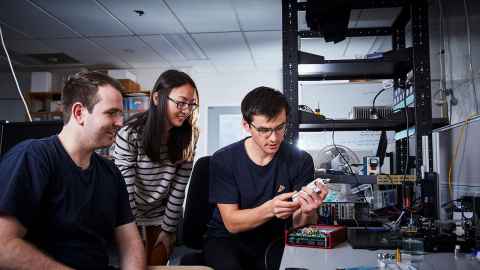Working towards a needle-free future
13 November 2018
Imagine never having to get pricked with a needle again?

A team at the University of Auckland’s Bioengineering Institute (ABI) has developed an improved needle-free jet injector that could mean the end of scary injections.
Needle-free injectors aren’t new – they have been used for mass inoculation since the 70s. But they have always been limited by the amount of fluid they could inject.
According to Dr James McKeage from ABI’s Bioinstrumentation lab, needle-free injections are typically used to administer insulin and vaccines because they involve very small volumes of fluid – no more than 0.3 millilitres.
“However, our work has made it possible to deliver a whole millilitre using the same size injector,” says Dr McKeage. “This means it can be also used for a wider range of applications such as antibiotics and anaesthetics. Ultimately we could replace needles altogether.”
Dr McKeage and his team have designed a double-piston ampoule – the nozzle part on an injector – that is five times as efficient as current single-piston ampoules. It means more fluid can be injected using standard motors, but also that volumes of 0.3 ml can be injected using smaller, lighter motors.
"Ultimately we could replace needles altogether."
What’s more, the ABI team have developed a permanent magnet linear synchronous motor which is four times as efficient as those currently used, meaning coupled with the new the double-piston ampoule, they can easily increase the delivery volume to 2ml or even more.
For most of us, the main drawback of using needles is that we just don’t like them. But Dr McKeage says there are many other reasons to switch to needle-free injectors.
“A lot of diseases get accidentally transmitted in hospitals because of needles, like when a nurse or doctor accidentally sticks themselves. And that means the handling of disposed needles is a very expensive and time-consuming procedure.”
“In the Third World, communities might not be able to afford enough needles so if people have to choose between reusing a needle or not getting the injection, they will often decide to reuse,” says Dr McKeage.
His team is also working on a way to use a laser light to measure the depth that fluid is injected. Some medications are more effective at different depths.
This could be life-changing for diabetics. At the moment diabetics have to inject themselves between two and five times a day with a needle and each time is very painful.
Another idea is how to use injectors to measure the glucose levels of diabetics. If the injector could first take a blood sample, it would be possible to calculate precisely the right amount of insulin to deliver – all without the use of needles.
This could be life-changing for diabetics, says researcher Bahareh Madadkhahsalmassi. “At the moment diabetics have to inject themselves between two and five times a day with a needle and each time is very painful,” she says.
“Infection is another issue – if the diabetic cannot afford a lot of needles they will reuse the same one many times, which greatly increases the chance for infection.”
Contact Tess Redgrave |Media Adviser
Tel: 09 923 7383 Mob: 027 562 5868
Email: t.redgrave@auckland.ac.nz